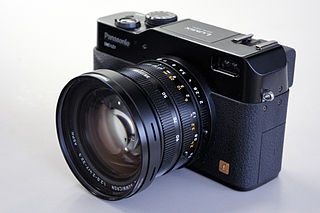
Lumix is Panasonic's brand of digital cameras, ranging from pocket point-and-shoot models to digital SLRs.
The Panasonic Lumix DMC-FZ7 is a six megapixel superzoom bridge digital camera that utilizes Panasonic's Venus II Engine. It features a 12× zoom lens and several modes of operation. It was replaced in 2007 by the DMC-FZ8

Panasonic Lumix DMC-FZ50 is a superzoom bridge digital camera by Panasonic.

The Panasonic Lumix DMC-FZ8 is a 7 megapixel superzoom bridge digital camera made by Panasonic. As with most Panasonic Lumix cameras, it uses a Venus Engine, in this case, the Venus Engine III. It supports the Raw image format and has the same sensor size and zoom level as its predecessor, the Panasonic Lumix DMC-FZ7.

The Micro Four Thirds system is a standard released by Olympus and Panasonic in 2008, for the design and development of mirrorless interchangeable lens digital cameras, camcorders and lenses. Camera bodies are available from Blackmagic, DJI, JVC, Kodak, Olympus, Panasonic, Sharp, and Xiaomi. MFT lenses are produced by Cosina Voigtländer, DJI, Kowa, Kodak, Mitakon, Olympus, Panasonic, Samyang, Sharp, Sigma, SLR Magic, Tamron, Tokina, TTArtisan, Veydra, Xiaomi, Laowa, Yongnuo, Zonlai, Lensbaby, Kowa, Venus Optics and 7artisans amongst others.

The Panasonic Lumix DMC-FZ18 is a superzoom bridge digital camera that features:

The Panasonic Lumix DMC-FZ28 is a superzoom bridge digital camera, replacing the similar Panasonic Lumix DMC-FZ18. It was announced in 2008 and released for sale in the United Kingdom in August of that year. Like the FZ18 it has a Leica lens with an 18x optical zoom ratio. It has a slightly larger sensor than the FZ18, a 10.1-megapixel image resolution, and the newer Venus IV image processing engine.
The Panasonic Lumix DMC-FZ45 is a superzoom bridge digital camera, replacing the similar Panasonic Lumix DMC-FZ38 and earlier Panasonic Lumix DMC-FZ28. The Panasonic Lumix DMC-FZ40/FZ45 superzoom slots in where the FZ38/35 left off, featuring the same 25-600mm equiv. lens as the FZ100, but with a 14.1MP CCD sensor and simpler 230K dot 3.0 inch fixed LCD. The FZ40 also offers AVCHD Lite 720p HD video recording, manual shooting modes and the company’s Sonic Speed auto-focus system that offers the industry's fastest focus times.

The Panasonic Lumix DMC-GH2 is a digital camera with HD video recording capability that is part of the Micro Four Thirds system. Though commonly referred to as a DSLR camera, it has no mirror or optical viewfinder, but has instead both a fold-out LCD screen and a electronic viewfinder.

The Panasonic Lumix DMC-G3 is a digital mirrorless interchangeable lens camera adhering to the joint Olympus and Panasonic Micro Four Thirds System (MFT) system design standard. The Panasonic Lumix DMC-G3 is the eighth Panasonic MFT camera introduced under the standard and the thirteenth model MFT camera introduced by either Olympus or Panasonic, as of the G3 product announcement date.

The Panasonic Lumix DMC-G2 is a digital mirrorless interchangeable lens camera adhering to the Olympus and Panasonic developed Micro Four Thirds System (MFT) system design standard. It was announced in March 2010 along with a lesser featured Panasonic Lumix DMC-G10.

Panasonic Lumix DMC-GF3 is the eighth camera in Panasonic's Lumix G-series adhering to the Micro Four Thirds System (MFT) design standard, and was announced in June 2011.
The Panasonic Lumix DMC-FZ70 or Panasonic Lumix DMC-FZ72 is a DSLR-like ultrazoom bridge camera announced by Panasonic on July 18, 2013. It succeeds the Panasonic Lumix DMC-FZ62. FZ70 and FZ72 refer to the same camera model in different markets. The FZ70/72 has a 16 megapixel sensor and 20-1200mm equivalent, 60x optical zoom lens. Its successor is the FZ82 with a 18 megapixel sensor, 4K video and the same 60x optical zoom lens.

The Panasonic Lumix DMC-FZ1000 is a digital superzoom bridge camera by Panasonic. It went on sale in June 2014. It has a 20 megapixel 3:2 BSI-CMOS sensor and Leica-branded 25–400 mm equivalent focal length lens with a maximum aperture of f/2.8 to f/4. It has a 1-inch CMOS sensor and supports ISO film speeds from 80 to 25600, shutter speeds from 1/16000 s to 60 s and RAW capture, while the lowest physical shutter speed is 1/4000 s. The unit is equipped with five "Fn" function buttons which can be allocated to custom shortcuts.

The Sony Cyber-shot DSC-RX10 is a digital superzoom bridge camera made by Sony. It was announced on October 16, 2013.

The Panasonic Lumix DMC-LX100 is a compact camera with a 13 MP Four Thirds type 17.3mm x 13mm sensor announced by Panasonic on September 15, 2014. LX100 features an F1.7-2.8 24-75mm equivalent Leica-branded lens, 2764k dot Electronic viewfinder, 3" 921k dot LCD, built-in wireless and it can record 4K video at 30p or Full HD at 60p.

The Panasonic Lumix DMC-FZ5 is a superzoom bridge digital camera. It has Universal Serial Bus connectivity and has a mass of 326 grams (11.5 oz). It is featured with a black or silver model and was released by Panasonic in February 2005.
The Panasonic Lumix DMC-FZ1 is a compact digital camera announced by Panasonic on September 29, 2002.
The Panasonic Lumix DC-GX850/GX800 is an interchangeable lens mirrorless system digital camera announced by Panasonic on January 4, 2017.













